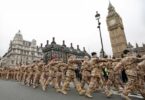Iqbal Khan
President Donald Trump’s visit to a portion of Asia presents an interesting case study in statecraft. Packaging of countries for the visit included China, and some of the countries America wants to employ for containing China-Japan, South Korea, Vietnam and the Philippines.
Rise of China and chaos in the US domestic politics have created greater disorder than expected and, that too, pretty fast. This environment has opened up more venues for anarchic Indian diplomacy in Asia. Its state terrorism in Indian occupied Kashmir has intensified, and Doklam fiasco is the latest manifestation of Indian hubris. Moreover, India is meddling in Afghanistan and carrying out terrorist attacks in Pakistan; America is not only overlooking these Indian actions, but is also encouraging it, in a hope that India would one day do heavy lifting for America’s ‘Contain China’ strategy.
Trump’s Asia tour had three driving objectives: to enhance reciprocity in the commercial activities; to boost alliances and partnership; and, to augment constituency for impeding, halting and reversing North Korea’s nuclear weap-ons programme. Visit was marred by inconsistencies and contradictions. In terms of achievements, it was more in terms of nuance than substance. Three things came to fore glaringly: America and China will continue to compete for political preeminence in Asia, and this will be a losing battle for Trump, and his successor(s), who are likely to have a hard time ceding America’s long-standing primacy in Asia; contradictions between Washington’s historic obligation to economic globalization and Trump’s “America First” policies are unlikely to smoothen; and, majority of toured countries had already begun to diversify their security dependence, even though before landing in Asia, Trump had warned the region not to test American resolve and promised to sell lots of advanced arms to its Asian allies.
During the visit, Trump also participated in two major regional summits – the forum for Asia Pacific Economic Cooperation, in Vietnam, and the East Asia Summit in the Philippines, alongside bilateral visits to Japan and South Korea. Of these, Trump’s visit to Beijing was undoubtedly the most important element of this sojourn, and North Korea was the most discussed topic.
Misplaced hype about 21stcentury being Asia’s century in general and China’s century in particular has unnerved the American strategists and its allies. Alongside feigning denial mode about this inevitable transition, America is following two-pronged strategy: Firstly, it is doing what all it could to divide Asia into 4-5 competing and quarrelling power centres; and secondly it is prompting neighbours of China to hype-up historic, but longtime dormant, conflicts pertaining territorial claims and resource sharing. China is handling American machinations through prudent diplomacy and apt maneuvers. Trump’s walking away from Paris Agreement on Climate Change and Trans-Pacific Partnership (TPP), a free trade deal, has unwittingly catapulted China on leadership role with regard to both these futuristic treaties. Yet, paradox is that Washington and Beijing need each other; and unwittingly, terms of a new economic and political settlement between the two are evolving.
Trump’s journey to Asia began in the shadow of North Korea’s nuclear and missile testing spree. To welcome Trump, Kim Jong-un had already sent two long range missiles over Japan and conducted its sixth and biggest nuclear test. This had prompted the Japanese citizens rehearsing drills in case of a nuclear attack. Despite harsher sanctions, Pyongyang has shown no sign of slowing down the pace of weapons development.
And to ward off the US pressure on North Korea’s nuclear pursuits, China dispatched a special envoy to North Korea on November 17. Envoy’s tour was hailed as a “big move” by US President Donald Trump. China has backed the UN sanctions on North Korea. China has also imposed its own banking and air travel restrictions on North Korea. President Xi had also floated a canny “dual track approach”. It calls for North Korea to freeze its missile and nuclear tests in return for the US and South Korea suspending their annual joint military exercises. According to James Acton, there is a lack of unity over what actions from North Korea might open the door to negotiations. While in Seoul, Trump told the North Koreans that the path to a better future begins with “a stop to your development of ballistic missiles, and complete, verifiable and total denuclearization.”
As regards trade, Beijing resorted to putting forth a package of commercial deals with American companies amounting to $250 billion. Xi was quite demonstrative in emphasizing Chinese partnership with America. He aptly declared that “the Pacific Ocean is big enough to accommodate both China and the United States”. He insisted that Beijing and Washington need to “jointly” promote peace and stability in Asia. The South China Sea has been quiet over the last few months, and China is going ahead with its sea focused development projects.
With regard to Trump’s credibility, even Japan and Korea are nervous that the US will back off from its bilateral trade agreements. Though Trump’s “America First!” slogan is only aimed at a domestic audience, yet it does not go down well with trade partners abroad. Tokyo wanted to know the contour of the US military co-operation. Seoul, literally in the firing line of its northern neighbour with artillery positioned over the border, was equally inquisitive about the same. And, paradoxically, after an unprecedented personal warning by Kim Jong-un to Trump, Seoul wanted Trump to tone down his rhetoric and keep options for dialogue open. Both Vietnam, which puts dissenting bloggers in jail, and the Philippines, with its controversial drug war, have a patchy Human Rights record. Trump has overloo-ked this aspect. And despite the stain of extrajudicial killings, Philippine President Rodrigo Duterte has best of relations with Trump.
Trump stood before a summit of Asian leaders keen on regional trade pacts and delivered a roaring “America first” message: “We are not going to let the United States be taken advantage of anymore,” Trump told CEOs on the sidelines of the Asia-Pacific Economic Cooperation conference. The message stood in sharp contrast to the behind-the-scenes negotiations taking place among other countries at the summit on a successor to TPP; minus the US; remaining 11 countries decided to go ahead with the partnership.
The US-Russia summit did not take place in Danang. However, a joint statement on Syria was issued that reaffirmed previous commitments to defeat the Islamic State. In Danang, President Trump issued two starkly contradictory calls on his trip to Asia: the nations of the world must rally behind the United States to confront the nuclear threat from North Korea, and, they should expect America to go its own way on trade. Reconciling such messages will be hard, and it may determine the near-term fate of the US as a Pacific power.
Robert Daly in his November 21 article captioned “China and the US are Now Equals. What Happens Next?”, carried by Newsweek aptly summarizes President Trump’s Asia visit: “Asia trip was historic in one respect: it belatedly focused American attention on the competition between the United States and China for global primacy. China has risen, the era of uncontested American leadership has ended… America is no longer number one; it’s a tie, for now”. Senate Minority Leader Chuck Schumer called Trump’s trip a “flop.” “He seemed far more interested in pomp and circumstance than advancing American interests in a region that is increasingly looking to China for leadership,” said Schumer. “And after the president’s performance, those countries are going to turn more to China”, he added.
Contradictory messages illustrate Trump’s transactional approach to statecraft. These competing impulses have left allies and adversaries confused, alike, about America’s motives and staying power. Pakistan should firm-up its plans to safely engage with a wobbly America, at least from short to medium timeframe.






